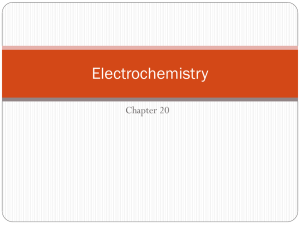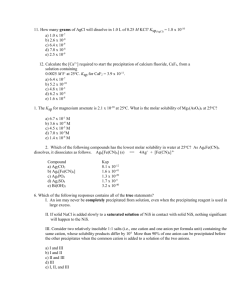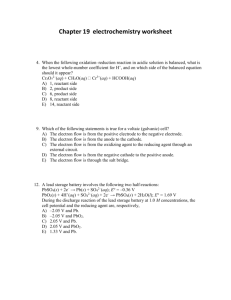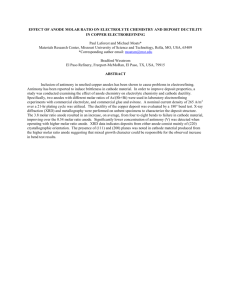worksheet _ 2 Chapter 20 Ans
advertisement
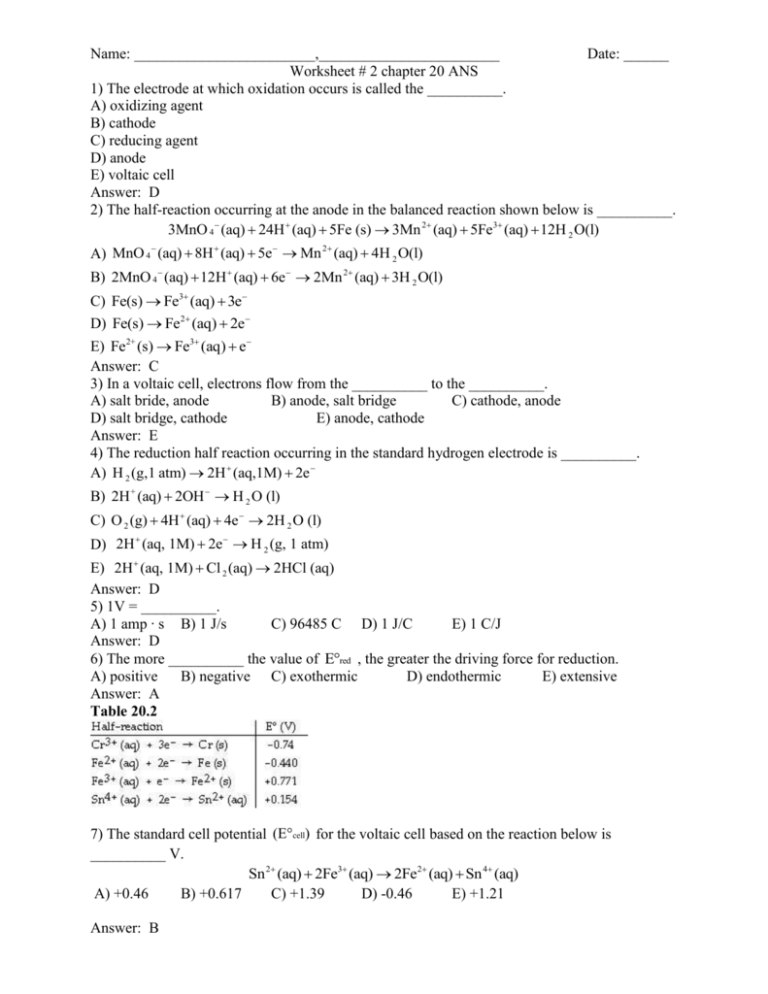
Name: ________________________,________________________ Date: ______ Worksheet # 2 chapter 20 ANS 1) The electrode at which oxidation occurs is called the __________. A) oxidizing agent B) cathode C) reducing agent D) anode E) voltaic cell Answer: D 2) The half-reaction occurring at the anode in the balanced reaction shown below is __________. 3MnO 4 (aq) 24H (aq) 5Fe (s) 3Mn 2 (aq) 5Fe3 (aq) 12H 2 O(l) A) MnO 4 (aq) 8H (aq) 5e Mn 2 (aq) 4H 2 O(l) B) 2MnO 4 (aq) 12H (aq) 6e 2Mn 2 (aq) 3H 2 O(l) C) Fe(s) Fe3 (aq) 3e D) Fe(s) Fe2 (aq) 2e E) Fe2+ (s) Fe3 (aq) e Answer: C 3) In a voltaic cell, electrons flow from the __________ to the __________. A) salt bride, anode B) anode, salt bridge C) cathode, anode D) salt bridge, cathode E) anode, cathode Answer: E 4) The reduction half reaction occurring in the standard hydrogen electrode is __________. A) H 2 (g,1 atm) 2H (aq,1M) 2e B) 2H + (aq) 2OH H 2 O (l) C) O 2 (g) 4H (aq) 4e 2H 2 O (l) D) 2H (aq, 1M) 2e H 2 (g, 1 atm) E) 2H (aq, 1M) Cl 2 (aq) 2HCl (aq) Answer: D 5) 1V = __________. A) 1 amp ∙ s B) 1 J/s C) 96485 C D) 1 J/C E) 1 C/J Answer: D 6) The more __________ the value of E°red , the greater the driving force for reduction. A) positive B) negative C) exothermic D) endothermic E) extensive Answer: A Table 20.2 7) The standard cell potential (E°cell) for the voltaic cell based on the reaction below is __________ V. Sn 2 (aq) 2Fe3 (aq) 2Fe2 (aq) Sn 4 (aq) A) +0.46 B) +0.617 C) +1.39 D) -0.46 E) +1.21 Answer: B 8) The standard cell potential (E°cell) for the voltaic cell based on the reaction below is __________ V. Cr (s) 3Fe3 (aq) 3Fe2 (aq) Cr 3 (aq) A) -1.45 B) +2.99 C) +1.51 D) +3.05 E) +1.57 Answer: C 9) The standard cell potential (E°cell) for the voltaic cell based on the reaction below is __________ V. 2Cr (s) 3Fe2 (aq) 3Fe(s) 2Cr 3 (aq) A) +0.30 B) +2.80 C) +3.10 D) +0.83 E) -0.16 Answer: A 10) The standard cell potential (E°cell) for the voltaic cell based on the reaction below is __________ V. 3Sn 4 (aq) 2Cr (s) 2cr 3 (aq) 3Sn 2 (aq) A) +1.94 B) +0.89 C) +2.53 D) -0.59 E) -1.02 Answer: B 11) Which transformation could take place at the anode of an electrochemical cell? A) Cr2 O7 2 Cr 2+ B) F2 toF C) O2 to H2O D) HAsO2 to As E) None of the above could take place at the anode. Answer: E 12) The purpose of the salt bridge in an electrochemical cell is to __________. A) maintain electrical neutrality in the half-cells via migration of ions. B) provide a source of ions to react at the anode and cathode. C) provide oxygen to facilitate oxidation at the anode. D) provide a means for electrons to travel from the anode to the cathode. E) provide a means for electrons to travel from the cathode to the anode. Answer: A 13) Which transformation could take place at the anode of an electrochemical cell? A) NO NO3 B) CO 2 C2O 4 2 C) VO2 VO2 D) H2 AsO4 H3AsO3 E) O2 H 2O2 Answer: A 14) Which transformation could take place at the cathode of an electrochemical cell? A) MnO2 MnO4 B) Br2 BrO3 C) NO HNO2 D) HSO 4 H 2SO3 E) Mn 2 MnO 4 Answer: D Table 20.1 15) Which of the halogens in Table 20.1 is the strongest oxidizing agent? A) Cl2 B) Br2 C) F2 D) I 2 E) All of the halogens have equal strength as oxidizing agents. Answer: C 16) Which one of the following types of elements is most likely to be a good oxidizing agent? A) alkali metals B) lanthanides C) alkaline earth elements D) transition elements E) halogens Answer: E 17) Which one of the following is the best oxidizing agent? A) H 2 B) Na C) O2 D) Li E) Ca Answer: C Answer (a) 2 Ag+ + 2 e- 2 Ag E = +0.80 v Cd – 2 e-- Cd2+ E = +0.40 v 2 Ag+ + Cd 2 Ag + Cd2+ E = +1.20v (b) Anions flow into the cadmium half-cell. As the cell operates, Cd2+ cations increase in number and need to be balanced by an equal number of anion charges from the salt bridge. (c) Cell voltage will increase. An increase in silver ion concentration will result in faster forward reaction and a higher cell potential. (d) Cell voltage will decrease. As the salt dissolves, the Cl– ion will cause the Ag+ ion to precipitate as AgCl and decrease the [Ag+]. This will result in a slower forward reaction and a decrease in cell potential. Since cadmium chloride is a soluble salt, it will not affect the cadmium half-cell. Answer: (a) (i) Zn(s) – 2 e- Zn2+(aq) (ii) Zn(s) + Co2+(aq) Zn2+(aq) + Co(s) (iii) oxid: Zn(s) – 2 e- Zn2+(aq) E = +0.76V 2+ red: Co (aq)+ 2 e- Co(s) E = –0.28V +0.48V





